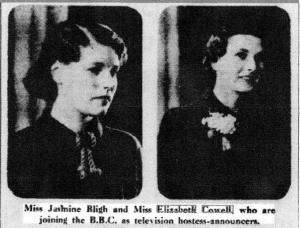Last year I had the opportunity to spend time researching the women involved in the development of early BBC television, from the experimental years of 1936-1939 and from the relaunch of the service following the end of the war, to the professionalization of the service by the 1950s. These women were undoubtedly pioneers who worked in a fairly wide range of roles in the organisation, given the limited opportunities afforded to women in the wider labour market during these years. Among them were the first announcers of television, Jasmine Bligh and Elizabeth Cowell, Mary Allan who was in make-up and wardrobe, and producer Mary Adams who worked in the Talks department. Each of them was central to the form and content of early television and helped define what television would grow into as it emerged as the dominant medium in subsequent decades. As Kate Murphy has demonstrated in her account of women in early BBC broadcasting history, the organisation was more accommodating to women and created more opportunities for them than many other companies and organisations (2016: 6). At the same time, however, women faced various forms of isolation, discrimination and career limitations that evidenced the difference between the public presentation of egalitarianism and the private practice of inequality.
In our current moment of heightened awareness of, and anger towards, the persistence of gender inequality in the British screen industries and beyond, it is interesting, if not dispiriting, to note the continued presence of this difference between public identity and private practice in the BBC and elsewhere in the broadcasting industry. In fact, it seems even more disastrous that there remains a problem with gender equality in terms of the proportion of women on television screens, the number of women involved in the production of television and in (some of) the public attitude towards women in the broadcasting industry more generally. In order to stress the striking parallels between the attitude towards women in early and in contemporary television, it is worth identifying where and how the exclusion of and discrimination against television’s women occurred in the early years of television, and comparing it to contemporary discourses on women’s work in television.
Perhaps the most obvious ‘gender problem’ that persists today is that of female presence on screen, particularly in roles that are perceived as authoritative. Recently the BBC has announced that it plans to have an equal percentage of male and female expert contributors by 2019 and has been quite vocal about the achievements of its gender equality project to date.
While the investment in gender equality is a welcome step towards correcting an obviously poor practice, it is worth noting that the BBC’s championing of equality has quite an extensive history. Indeed, according to Murphy, the BBC’s first Director General, Sir John Reith, promoted the practice of equality whereby women would be “on an equal footing” with men at the organisation (2016: 6). This materialised in television with the employment of Bligh and Cowell as the first television announcers, quite a meaningful action undertaken by the BBC.
The critical response to the presence of two women as announcers was mixed, with the Yorkshire Post and Leeds Intelligencer writing that “one of their primary functions is to please the eye-as much as the ears- and it would be incorrect to regard their inclusion in this week’s variety bill…as anything more than a tit-bit novelty.” (1936) Such attitudes appeared periodically throughout Cowell and Bligh’s tenure. However, when the BBC carried out television audience research in 1939, it was found that both of these female announcers were far more popular on the television service than their male counterpart, Leslie Mitchell. The report of this survey concluded that “viewers are well satisfied with Elizabeth Cowell and Jasmine Bligh…Almost the only criticism…was that Leslie Mitchell was apt to talk more than necessary…When asked whether they preferred men or women as announcers, 54% voted for women while very nearly all the rest said they had no marked preference.” (1939: 8) Despite the popularity of these women with the viewing public, the post-war roles available to women were largely relegated to ‘women’s programmes.’ When Bligh returned to the BBC after the war she could not find work as a television announcer and, even in terms of radio, was told that “there are no vacancies for women announcers on the regular staff, nor is the position likely to change.” (BBC Memo From Head of Staff Training Eileen MacLeod 12th sept 1951). Such was the back-tracking from the use of female television announcers that it wasn’t until 1960 that the BBC employed a female announcer for the news (Chambers et all, 2004: 9). Regardless of the public attitude towards the gender of the announcer, internally, the BBC was hesitant to continue employing women in such roles. This separation of intent and practice seems to have become an ingrained feature of the BBC, which, on the one hand, is quite vocal about its desire to have gender equality, yet, on the other, seems slow at enacting reform.
The BBC’s recent history paints an equally contradictory picture. Successful female presenters are meant to showcase the BBC’s progressive attitude towards gender equality on screen, yet some overarching institutional practices suggest a far less equitable work environment. More generally, the ratio of male to female presenters, experts and reporters on BBC news as per a 2015 report shows that men are far more numerous than women. A survey of panel shows carried out between 2014 and 2017 indicates a similarly unequal gender ratio across a number of BBC channels. In other words, although the BBC commenced its television service with a significant female presence, it has not managed to match this parity of representation in recent years. Following Miriam O’Reilly’s age and gender discrimination case against the BBC in 2014, one BBC executive indicated that broadcasters assumed that older women would be unpopular with audiences, despite having no evidence to support this notion. Much like television during the post-war years, then, the BBC has more faith in male presenters regardless of whether the public shows a preference one way or the other. Most obviously, the recent exposure of the pay gap between male and female staff, including key presenters, suggests that the Reithian ideal of “equal footing” is yet to be realised. Indeed, for some female presenters, not only did the BBC fail to offer equal pay for equal work but sometimes resisted implementing equal pay when it was challenged by these presenters.
It is perhaps no surprise, then, that the BBC’s declaration of a plan to achieve gender balance of expert contributors has been met with some scepticism by Women’s Equality party leader Sophie Walker noting that the BBC is presenting what should be everyday practice as an innovative one. She also notes that this could be an effort to distract from the aforementioned pay gap issue. If the BBC had any claims towards innovation or progressiveness, it would more aptly describe its early years. However, its most recent series of gender crises suggest that it might more accurately be described as regressive. Of course, similar claims might be made about other broadcasters, but the case of the BBC is possibly more telling since it seemed more enlightened a century ago than it is today.
Sarah Arnold is Lecturer in Gender & Production Studies at Maynooth University. She is preparing the book Television, Technology and Gender: New Platforms and New Audiences. Her previous books include Maternal Horror Film: Melodrama and Motherhood and the co-authored Film Handbook. Her research focuses on viewing spaces and environments of television and film, particularly in the context of gender and emergent technologies. She is a regular contributor to the Critical Studies in Television blog.







